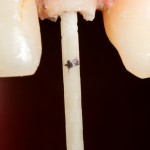
Intra-radicular posts have been used in the restoration of endodontically treated teeth for hundreds of years. Posts can be broadly classified as metallic and non-metallic. Metallic posts may be cast from noble or base metal alloys or prefabricated from gold alloys, stainless steel, and titanium alloys. carbon fibre, polyethylene, zirconia ceramic, and glass fibre have all being used to make non-metallic posts.
The aim of this review was to assess the comparative efficacy of fibre and metal posts used for the restoration of endodontically treated teeth.
Methods
A protocol was registered on the PROSPERO database. Searches were conducted in the Cochrane Central, Medline/PubMed and Scopus databases. Randomised controlled trials (RCTs) assessing the comparative efficacy of fibre posts and metal posts for the restoration of endodontically treated teeth were considered. The primary outcome was tooth fracture with post or core fracture, debonding of the post, and secondary caries as secondary outcomes.
Two reviewers independently selected studies extracted data and assessed risk of bias using the Cochrane risk of bias tool (RoB 2.0). Risk ratios (RR) and 95% confidence intervals were used as summary statistics for binary outcomes and standard pairwise meta-analysis undertaken along with a network meta-analysis (NMA). Posts were ranked according to their efficacy using the Surface Under the Cumulative Ranking (SUCRA) system.
Results
- 25 RCTs were included.
- 7 RCTs were considered to be at low risk of bias, 2 at high risk with 16 studies of some concern.
- 12 RCTs comparing 9 interventions were included in the NMA for the relative risk of preventing fracture of the tooth as compared with no post. Compared with no posts fibre posts significantly prevented tooth fracture, RR= 0.15 (95%CI: 0.06 to 0.33). SUCRA scores for different post types are shown in the table below.
| Relative Risk (95% CI) | SUCRA Rank (Score) | |
| Prefabricated carbon fibre (PCF) | 0.06 (0.00 to 0.54) | 1 (86.7) |
| Custom glass fibre (CGF) | 0.15 (0.04 to 0.52) | 2 (75.4) |
| Prefabricated glass fibre (PGF) | 0.22 (0.07 to 0.62) | 3 (64.9) |
| Custom gold alloy (CGA) | 0.26 (0.03 to 1.96) | 4 (60.0) |
| Prefabricated gold alloy (PGA) | 0.22 (0.00 to 8.30) | 5 (55.4) |
| Custom Co-Cr (CCC) | 0.59 (0.05 to 5.86) | 6 (35.1) |
| Prefabricated titanium (PT) | 0.58 (0.11 to 2.97) | 7 (34.1) |
| Custom titanium (CT) | 1.18 (0.23 to 5.95) | 8 (19.0) |
- 6 RCTs comparing 6 interventions were included in the NMA for the relative risk of preventing post or core fracture compared with no posts with no statistically significant differences found.
- 15 RCTs comparing 12 interventions were included in a NMA of the relative risk of preventing debonding or loss of retention of a post as compared with no post. Compared with no post Fibre posts, RR = 0.39 (5%CI: 0.27 to 0.56) and metal posts, RR = 0.24 (95%CI:0.12 to 0.46) significantly prevent debonding or loss of retention of a post or core.
- 9 RCTs comparing 8 interventions were included in the NMA of the relative risk of secondary caries as compared with no post with no significant differences were identified.
Conclusions
The authors concluded: –
The use of a fibre post when indicated results in reduced risk of tooth fracture as compared with no post. Prefabricated carbon fibre posts, prefabricated glass fibre posts, and custom glass fibre posts reveal a lower risk of tooth fracture. Overall, the use of prefabricated glass fibre posts had a lower risk of tooth fracture, debonding, and secondary caries. However, more trials with longer follow-up periods are recommended to enhance the certainty of evidence.
Comments
A protocol for the review was registered with the PROSPERO database and searches conducted in 3 major databases with only RCTs being included. An earlier review by Martins et al (Dental Elf – 13th Aug 2021) comparing fibre and metal posts found no differences between them in terms of failure rates. The Martin review included 10 studies of which 6 were assessed as RCTs compared with the current review which includes 25 RCTs. The findings of this review suggest better outcomes with fibre posts however, only 7 of the included trials were considered to be at low risk of bias. Future RCTs should be well conducted and reported following SPIRIT and CONSORT guidance and use a common outcome set (COMET).
Links
Primary Paper
Giok KC, Veettil SK, Menon RK. Comparative effectiveness of fiber and metal posts in the restoration of endodontically treated teeth: A systematic review with network meta-analysis. J Prosthet Dent. 2023 Oct 10:S0022-3913(23)00569-3. doi: 10.1016/j.prosdent.2023.08.022. Epub ahead of print. PMID: 37827970.
Other references
Dental Elf – 13th Aug 2021
Fibre or metal posts for restoring endodontically treated teeth?
Dental Elf – Fibre post blogs
